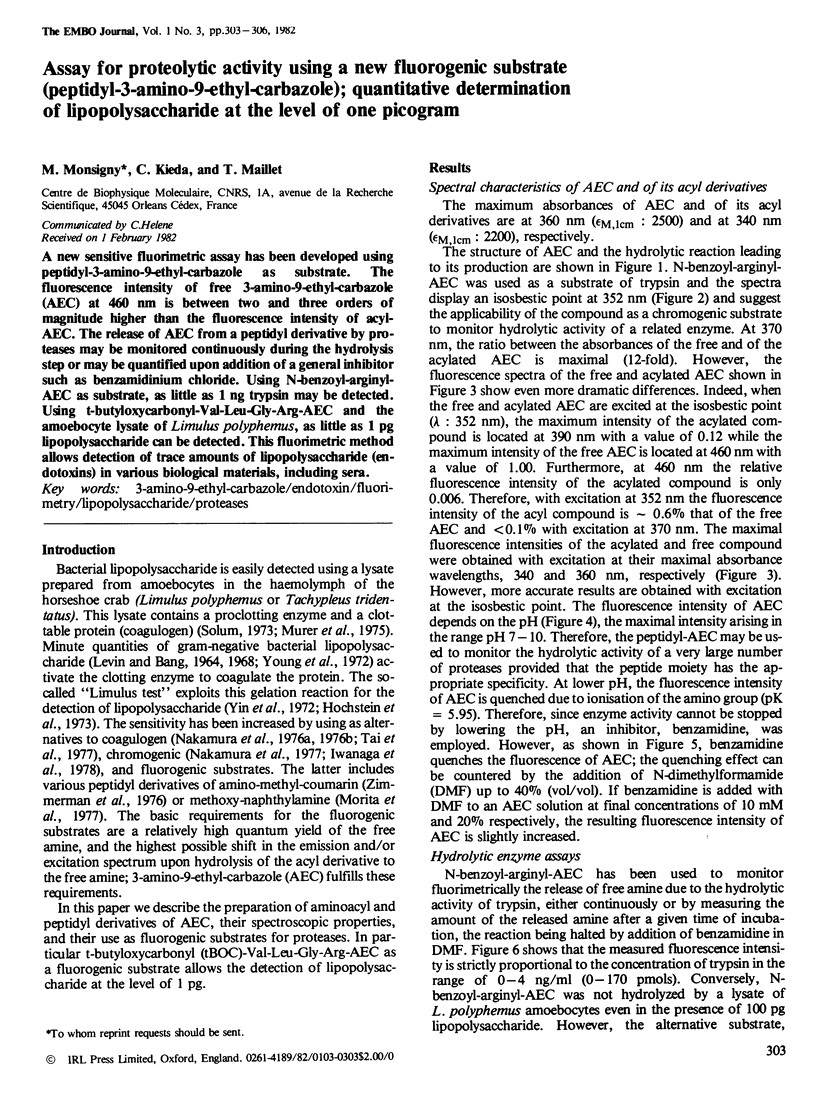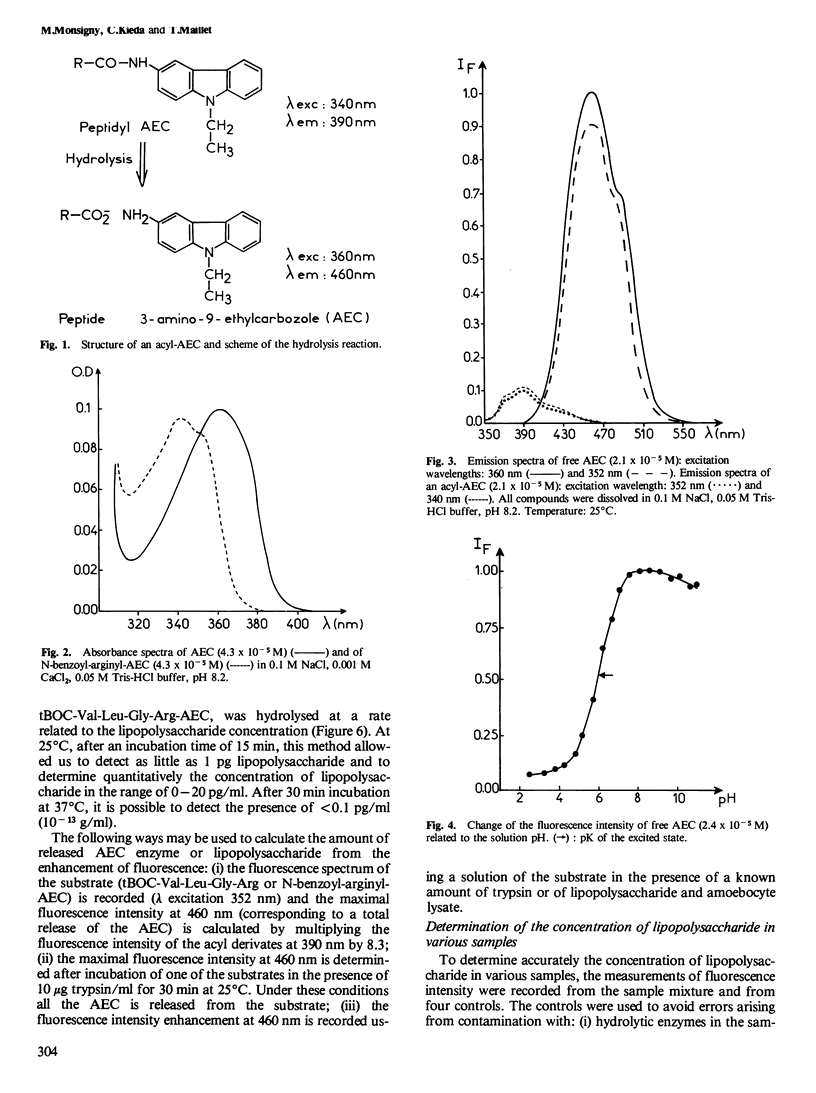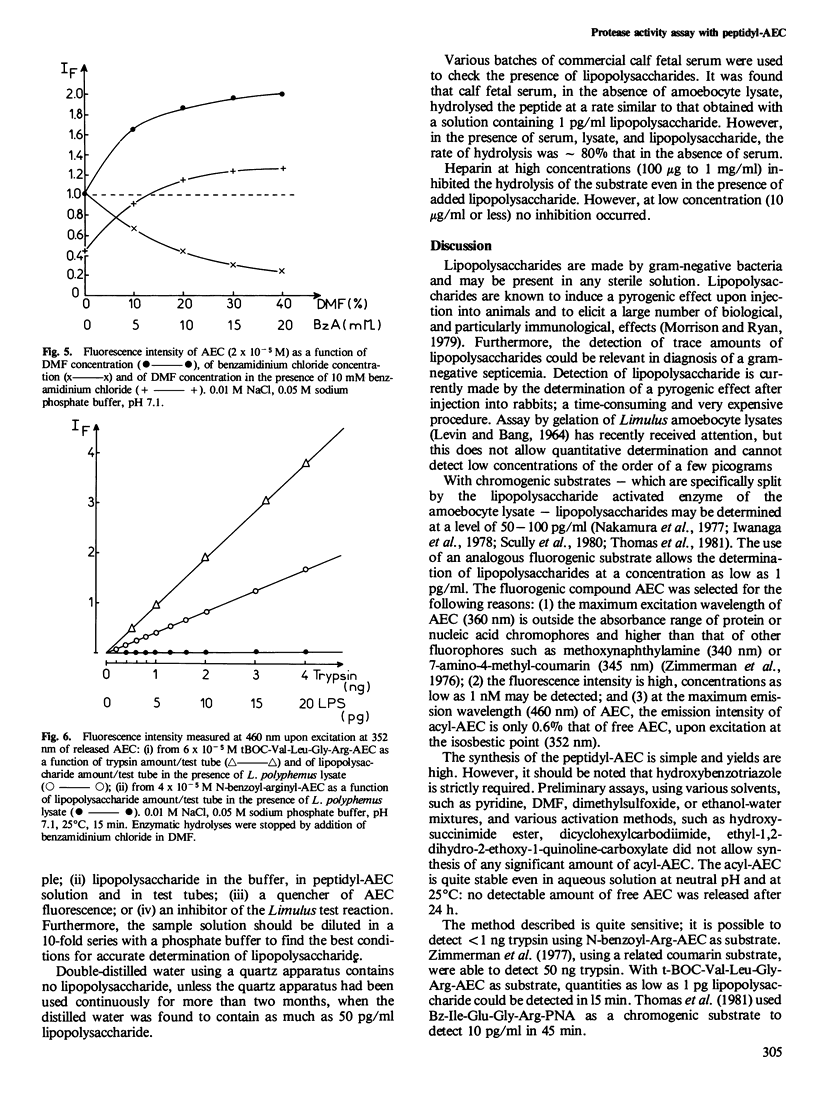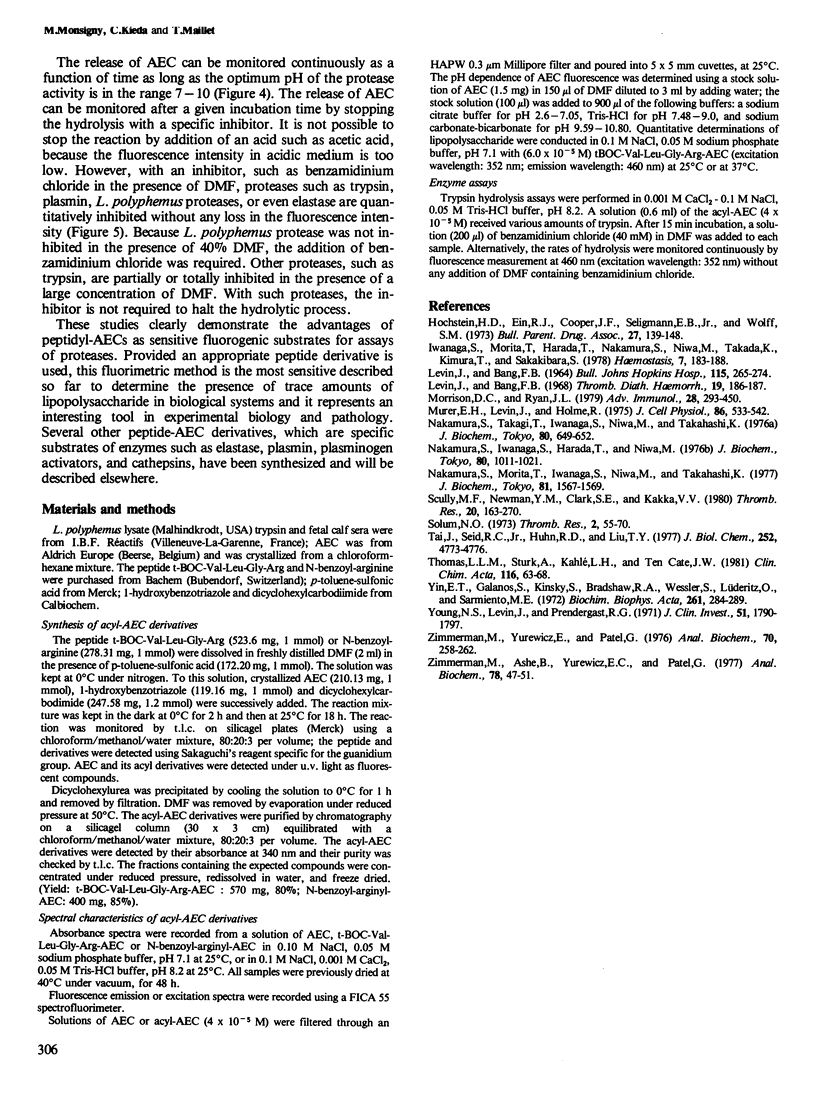Abstract
A new sensitive fluorimetric assay has been developed using peptidyl-3-amino-9-ethyl-carbazole as substrate. The fluorescence intensity of free 3-amino-9-ethyl-carbazole (AEC) at 460 nm is between two and three orders of magnitude higher than the fluorescence intensity of acyl-AEC. The release of AEC from a peptidyl derivative by proteases may be monitored continuously during the hydrolysis step or may be quantified upon addition of a general inhibitor such as benzamidinium chloride. Using N-benzoyl-arginyl-AEC as substrate, as little as 1 ng trypsin may be detected. Using t-butyloxycarbonyl-Val-Leu-Gly-Arg-AEC and the amoebocyte lysate of Limulus polyphemus, as little as 1 pg lipopolysaccharide can be detected. This fluorimetric method allows detection of trace amounts of lipopolysaccharide (endotoxins) in various biological materials, including sera.
Full text
PDF



Selected References
These references are in PubMed. This may not be the complete list of references from this article.
- Hochstein H. D., Elfin R. J., Cooper J. F., Seligmann E. B., Jr, Wolff S. M. Further developments of Limulus Amebocyte Lysate test. Bull Parenter Drug Assoc. 1973 May-Jun;27(3):139–148. [PubMed] [Google Scholar]
- Iwanaga S., Morita T., Harada T., Nakamura S., Niwa M., Takada K., Kimura T., Sakakibara S. Chromogenic substrates for horseshoe crab clotting enzyme. Its application for the assay of bacterial endotoxins. Haemostasis. 1978;7(2-3):183–188. doi: 10.1159/000214260. [DOI] [PubMed] [Google Scholar]
- LEVIN J., BANG F. B. THE ROLE OF ENDOTOXIN IN THE EXTRACELLULAR COAGULATION OF LIMULUS BLOOD. Bull Johns Hopkins Hosp. 1964 Sep;115:265–274. [PubMed] [Google Scholar]
- Levin J., Bang F. B. Clottable protein in Limulus; its localization and kinetics of its coagulation by endotoxin. Thromb Diath Haemorrh. 1968 Mar 31;19(1):186–197. [PubMed] [Google Scholar]
- Morrison D. C., Ryan J. L. Bacterial endotoxins and host immune responses. Adv Immunol. 1979;28:293–450. doi: 10.1016/s0065-2776(08)60802-0. [DOI] [PubMed] [Google Scholar]
- Mürer E. H., Levin J., Holme R. Isolation and studies of the granules of the amebocytes of Limulus polyphemus, the horseshoe crab. J Cell Physiol. 1975 Dec;86(3 Pt 1):533–542. doi: 10.1002/jcp.1040860310. [DOI] [PubMed] [Google Scholar]
- Nakamura S., Iwanaga S., Harada T., Niwa M. A clottable protein (coagulogen) from amoebocyte lysate of Japanese horseshoe crab (Tachypleus tridentatus). Its isolation and biochemical properties. J Biochem. 1976 Nov;80(5):1011–1021. doi: 10.1093/oxfordjournals.jbchem.a131357. [DOI] [PubMed] [Google Scholar]
- Nakamura S., Morita T., Iwanaga S., Niwa M., Takahashi K. A sensitive substrate for the clotting enzyme in horseshoe crab hemocytes. J Biochem. 1977 May;81(5):1567–1569. [PubMed] [Google Scholar]
- Nakamura S., Takagi T., Iwanaga S., Niwa M., Takahashi K. A clottable protein (coagulogen) of horseshoe crab hemocytes. Structural change of its polypeptide chain during gel formation. J Biochem. 1976 Sep;80(3):649–652. doi: 10.1093/oxfordjournals.jbchem.a131323. [DOI] [PubMed] [Google Scholar]
- Scully M. F., Newman Y. M., Clark S. E., Kakkar V. V. Evaluation of a chromogenic method for endotoxin measurement. Thromb Res. 1980 Oct 15;20(2):263–270. doi: 10.1016/0049-3848(80)90391-6. [DOI] [PubMed] [Google Scholar]
- Tai J. Y., Seid R. C., Jr, Huhn R. D., Liu T. Y. Studies on Limulus amoebocyte lysate II. Purification of the coagulogen and the mechanism of clotting. J Biol Chem. 1977 Jul 25;252(14):4773–4776. [PubMed] [Google Scholar]
- Thomas L. L., Sturk A., Kahlé L. H., ten Cate J. W. Quantitative endotoxin determination in blood with a chromogenic substrate. Clin Chim Acta. 1981 Oct 8;116(1):63–68. doi: 10.1016/0009-8981(81)90169-8. [DOI] [PubMed] [Google Scholar]
- Yin E. T., Galanos C., Kinsky S., Bradshaw R. A., Wessler S., Lüderitz O., Sarmiento M. E. Picogram-sensitive assay for endotoxin: gelation of Limulus polyphemus blood cell lysate induced by purified lipopolysaccharides and lipid A from Gram-negative bacteria. Biochim Biophys Acta. 1972 Jan 28;261(1):284–289. doi: 10.1016/0304-4165(72)90340-6. [DOI] [PubMed] [Google Scholar]
- Young N. S., Levin J., Prendergast R. A. An invertebrate coagulation system activated by endotoxin: evidence for enzymatic mediation. J Clin Invest. 1972 Jul;51(7):1790–1797. doi: 10.1172/JCI106980. [DOI] [PMC free article] [PubMed] [Google Scholar]
- Zimmerman M., Ashe B., Yurewicz E. C., Patel G. Sensitive assays for trypsin, elastase, and chymotrypsin using new fluorogenic substrates. Anal Biochem. 1977 Mar;78(1):47–51. doi: 10.1016/0003-2697(77)90006-9. [DOI] [PubMed] [Google Scholar]
- Zimmerman M., Yurewicz E., Patel G. A new fluorogenic substrate for chymotrypsin. Anal Biochem. 1976 Jan;70(1):258–262. doi: 10.1016/s0003-2697(76)80066-8. [DOI] [PubMed] [Google Scholar]


